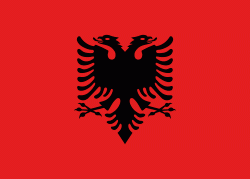Dropull (Bashkia Dropull)
Dropull (Dropulli; Δρόπολη or Δερόπολη Dropoli or Deropoli) is a municipality in Gjirokastër County, in southern Albania. The region stretches from south of the city of Gjirokastër to the Greek–Albanian border, along the Drino river. The region's villages are part of the Greek "minority zone" recognized by the Albanian government, in which majorities of ethnic Greeks live.
The municipality Dropull was created in 2015 by the merger of the former municipalities Dropull i Poshtëm, Dropull i Sipërm and Pogon. The seat of the municipality is the village Sofratikë. According to the 2011 census the total population is 3,503; according to the civil registry of that year, which counts all citizens including those who live abroad, it is 23,247. The municipality covers an area of 448.45 km2.
A city called Hadrianopolis was founded in the region by the Roman emperor Hadrian (r. 117–138). The Synecdemus of Hierocles, which contains a list of the administrative divisions and cities of the Byzantine Empire during the time of Theodosius II (r. 402–450), mentions the city of Αδριανούπολις (Adrianoúpolis) and places it in the region of Dropull. With the gradual adoption of Christianity, the city became a diocese sometime before 431; initially under the jurisdiction of the Metropolis of Nicopolis, and later under the Metropolis of Ioannina. The diocese of Adrianoúpolis is mentioned in the sources without interruption, from the 5th century onwards. In a letter of emperor Leo III (r. 717-741) to the metropolitan bishop of Nikopolis, the bishop of Adrianoúpolis (Αδριανουπόλεως) is also mentioned, while in a source at the end of the 12th century the latter is mentioned as bishop of Drinoúpolis (Δρινουπόλεως). The relevant attestations also include the name Adernoboli, as recorded by the Arab traveler Muhammad al-Idrisi at the end of the 12th century. Also, in the Chronicle of the Tocco, written around 1400, the form Δερνόπολιν (Dernópolin) is attested. According to Hammond, the first attestation of the name Drinoúpolis (Δρινούπολις) is from the 8th century, while according to Sakellariou from the 11th century as Dryinoúpolis (Δρυϊνούπολις); however Kyriazis supports that this form was a literary creation. The region is today called in Albanian Dropull or def. form Dropulli, and in Greek Δρόπολη (Drópoli), Δερόπολη (Derópoli) or Dhropolis.
The municipality Dropull was created in 2015 by the merger of the former municipalities Dropull i Poshtëm, Dropull i Sipërm and Pogon. The seat of the municipality is the village Sofratikë. According to the 2011 census the total population is 3,503; according to the civil registry of that year, which counts all citizens including those who live abroad, it is 23,247. The municipality covers an area of 448.45 km2.
A city called Hadrianopolis was founded in the region by the Roman emperor Hadrian (r. 117–138). The Synecdemus of Hierocles, which contains a list of the administrative divisions and cities of the Byzantine Empire during the time of Theodosius II (r. 402–450), mentions the city of Αδριανούπολις (Adrianoúpolis) and places it in the region of Dropull. With the gradual adoption of Christianity, the city became a diocese sometime before 431; initially under the jurisdiction of the Metropolis of Nicopolis, and later under the Metropolis of Ioannina. The diocese of Adrianoúpolis is mentioned in the sources without interruption, from the 5th century onwards. In a letter of emperor Leo III (r. 717-741) to the metropolitan bishop of Nikopolis, the bishop of Adrianoúpolis (Αδριανουπόλεως) is also mentioned, while in a source at the end of the 12th century the latter is mentioned as bishop of Drinoúpolis (Δρινουπόλεως). The relevant attestations also include the name Adernoboli, as recorded by the Arab traveler Muhammad al-Idrisi at the end of the 12th century. Also, in the Chronicle of the Tocco, written around 1400, the form Δερνόπολιν (Dernópolin) is attested. According to Hammond, the first attestation of the name Drinoúpolis (Δρινούπολις) is from the 8th century, while according to Sakellariou from the 11th century as Dryinoúpolis (Δρυϊνούπολις); however Kyriazis supports that this form was a literary creation. The region is today called in Albanian Dropull or def. form Dropulli, and in Greek Δρόπολη (Drópoli), Δερόπολη (Derópoli) or Dhropolis.
Map - Dropull (Bashkia Dropull)
Map
Country - Albania
 |
 |
| Flag of Albania | |
Albania has been inhabited by different civilisations over time, such as the Illyrians, Thracians, Ancient Greeks, Romans, Byzantines, Venetians, and Ottomans. The Albanians established the autonomous Principality of Arbër in the 12th century. The Kingdom of Albania and Principality of Albania formed between the 13th and 14th centuries. Prior to the Ottoman conquest of Albania in the 15th century, the Albanian resistance to Ottoman expansion into Europe led by Skanderbeg won them acclaim over most of Europe. Albania remained under Ottoman rule for nearly five centuries, during which many Albanians (known as Arnauts) attained high-ranking offices in the empire, especially in the Southern Balkans and Egypt. Between the 18th and 19th centuries, cultural developments, widely attributed to Albanians having gathered both spiritual and intellectual strength, conclusively led to the Albanian Renaissance. After the defeat of the Ottomans in the Balkan Wars, the modern nation state of Albania declared independence in 1912. In the 20th century, the Kingdom of Albania was invaded by Italy, which formed Greater Albania before becoming a protectorate of Nazi Germany. Enver Hoxha formed the People's Socialist Republic of Albania after World War II, modeled under the terms of Hoxhaism. The Revolutions of 1991 concluded the fall of communism in Albania and eventually the establishment of the current Republic of Albania.
Currency / Language
| ISO | Currency | Symbol | Significant figures |
|---|---|---|---|
| ALL | Albanian lek | L | 2 |
| ISO | Language |
|---|---|
| SQ | Albanian language |
| EL | Greek language |















